
- Join our Team
- Online Platform Tutorial
- TEFL Courses
- Contact Us / FAQ
Forgot Username or Password
- Active vs. Passive Voice
- Adverbial Clauses
- Adverbial Phrases
- Be Going To Statements
- Be Going To Wh Questions
- Be Going To Yes/No Questions
- Be Going To & Present Continuous
- Comparatives
- Superlatives
- Comparatives & Superlatives
- Zero Conditional
- First Conditional
- Second Conditional
- Third Conditional
- Mixed Conditionals
- Future Continuous
- Future Continuous vs. Future Perfect
- Future Perfect Continuous
- Future Perfect Simple
- Future Simple
- Future Tenses
- Future Time Clauses
- Gerunds & Infinitives
- Have Got & Has Got
- I wish & If only
- Imperatives
- Irregular Verbs
- Narrative Tenses
- Noun Clauses
- Noun Phrases
- Passive Voice
- Past Continuous
- Past Perfect
- Past Perfect Continuous
- Past Perfect Simple & Continuous
- Past Simple Affirmative & Negative
- Past Simple Passive
- Past Simple Regular Verbs
- Past Simple Was and Were
- Past Simple Wh Questions
- Past Simple Yes/No Questions
- Past Simple vs. Past Continuous
- Past Simple vs. Present Perfect
- Past Tense Review
- Present Continuous
- Present Perfect
- Present Perfect Continuous
- Present Perfect - Ever and Never
- Present Perfect - For and Since
- Present Perfect - Just, Yet & Already
- Present Simple Affirmative & Negative
- Present Simple Passive
- Present Simple vs. Present Continuous
- Present Simple vs. Present Perfect
- Present Simple Wh Questions
- Present Simple Yes/No Questions
- Present Tense Review
- Question Words
- Relative Clauses
- Reported Speech
- Subject-Verb Agreement
- Tag Questions
- There is & There are
- Wh Questions
- Abstract Nouns
- Adjective-Noun Collocations
- Adjectives of Feeling & Emotion
- Adjectives of Opinion
- Adjectives of Quantity
- Adjective Opposites
- Adjective Order
- Adjective-Preposition Collocations
- -ed and -ing Adjectives
- Adverb-Adjective Collocations
- Adverb Order
- Adverbs of Affirmation & Negation
- Adverbs of Degree
- Adverbs of Frequency
- Adverbs of Manner
- Adverbs of Place
- Adverbs of Time
- Articles - a, an, the
- Causative Verbs
- Collective Nouns
- Common & Proper Nouns
- Compound Adjectives
- Compound Nouns
- Concrete Nouns
- Conjunctions
- Countable & Uncountable Nouns
- Demonstrative Adjectives
- Demonstrative Pronouns
- Dependent Prepositions
- Indefinite Pronouns
- Intensifiers & Mitigators
- Interjections
- Modal Verbs of Ability
- Modals of Deduction & Speculation
- Modals of Necessity
- Modals of Obligation & Prohibition
- Modals of Possibility & Certainty
- Onomatopoeia
- Parts of Speech
- Phrasal Verbs
- Possessives
- Prepositions of Movement
- Prepositions of Place
- Prepositions of Time
- Proper Adjectives
- Quantifiers
- Reflexive Pronouns
- Sense Verbs and Adjectives
- Singular & Plural Nouns
- So and Such
- Subject & Object Pronouns
- Too and Enough
- Transition Words
- Verb-Noun Collocations
- Agreeing & Disagreeing
- Asking Permission
- At the Dentist's
- At the Doctor's
- Being Polite
- Classroom Language
- Complaining & Apologizing
- Complimenting
- Critical Thinking & Problem Solving
- Describing Character & Personality
- Describing People's Appearance
- Describing Places
- Describing Things
- Etiquette and Manners
- Getting Around
- Getting to Know You
- Giving Advice
- Giving Directions
- Giving Opinions
- Giving Personal Information
- Greetings & Introductions
- Indirect Questions
- Likes and Dislikes
- Making Arrangements
- Making Decisions
- Making Excuses
- Making Invitations
- Making Offers & Promises
- Making Requests
- Making Suggestions
- Online Communication
- Ordering Food & Drink
- Social Media
- Telephoning
- Times and Dates
- British English vs. American English
- Cities, Towns & Places
- Clothes & Fashion
- Computers & Smartphones
- Countries & Nationalities
- Crime, Law & Punishment
- Cultural Celebrations
- Daily Routines
- Everyday Obects
- Family & Relationships
- Food & Drink
- Going Out & Entertainment
- Health & Fitness
- Hobbies & Free Time
- Houses, Rooms & Furniture
- Jobs & the Workplace
- Love, Romance & Dating
- Modes of Transport
- Parts of the Body
- Reading Comprehension
- Shapes & Measurements
- The Natural World
- Time Expressions
- TV & Film
- Valentine's Day
- Academic Collocations
- Academic Phrasal Verbs
- Academic Reading Comprehension
- AWL Sublist 1 & 2
- Cause and Effect Essays
- Compare and Contrast Essays
- Discussion Essays
- Discussions
- Essay Writing
- Paragraph Writing
- Persuasive Essays
- Presentation Skills
- Problem Solution Essays
- Punctuation
- Reading Skills
- Referenced Essays
- Study Skills
- The Writing Process
- Business Collocations
- Business Emails
- Business Idioms
- Business Meetings
- Business Negotiations
- Business Phrasal Verbs
- Closing a Presentation
- Describing Graphs & Charts
- Presentation Language & Structure
- Resumes, CVs & Email Cover Letters
- Starting a Presentation
- Talking About Jobs
- Answer Games
- Brainstorming Games
- Category Games
- Classic Childhood Games
- Counting Games
- Describing Games
- Drawing Games
- Drilling Activity Games
- First Day of Class Games
- Flashcard Games
- Grammar Games
- Hangman Games
- Listening Games
- Miming Games
- Music Games
- Question & Answer Games
- Sentence Race Games
- Spelling Games
- TV Game Shows
- Vocabulary Games
- Word Association Games
- Yes/No Question Games
- Classroom Interaction Patterns
- Classroom Management
- Concept Checking
- Cultural Awareness
- Developing Students' Listening Skills
- Developing Students' Reading Skills
- Developing Students' Speaking Skills
- Eliciting Techniques
- ESL Dictations
- How to Introduce a Lesson
- How to Use Music in ESL Class
- Lesson Planning
- Making Teaching Materials Relevant
- Problems Learning English
- Teaching English Idioms
- Teaching English Vocabulary
- Teaching Large Classes
- Teaching Mixed-Ability Classes
- Teaching Small Classes
- The First Day of Class
- Using Correction in Class
- Using Song Gap Fills
- Online Membership
- ESL Essentials eBook Series

Essay Writing EAP Worksheets
- Intermediate ( B1 )
- Upper-intermediate ( B2 )

Academic Style
Eap academic style worksheet - vocabulary and reading exercises: matching, identifying, providing synonyms - intermediate (b1-b2) - 45 minutes.
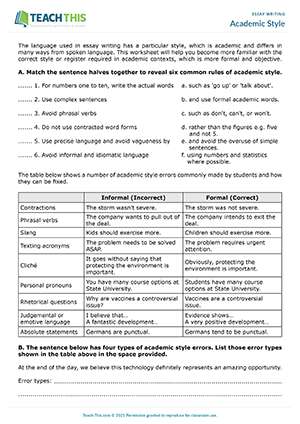
Body Paragraphs
Eap body paragraphs worksheet -reading and writing exercises: writing sentences, creating a paragraph outline, writing paragraphs - intermediate (b1) - 60 minutes.
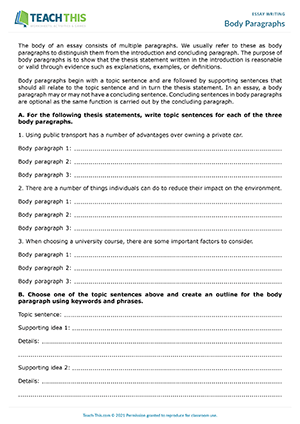
Concluding Paragraphs
Eap concluding paragraphs worksheet - reading and writing exercises: paraphrasing, writing sentences from prompts, writing a concluding paragraph - intermediate (b1) - 60 minutes.
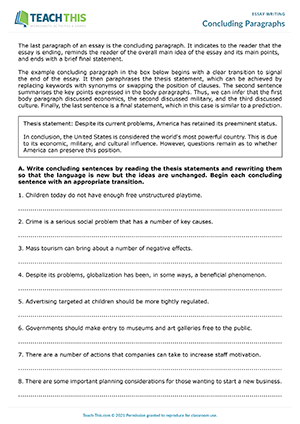
Essay Cohesion, Coherence and Unity
Eap essay cohesion, coherence and unity worksheet - reading and writing exercises: categorising, gap-fill, identifying, rewriting a paragraph - intermediate (b1) - 60 minutes.
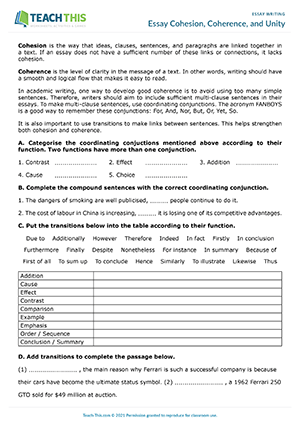
Essay Outlines
Eap essay outlines worksheet - reading and writing exercises: identifying, brainstorming, creating an essay outline, writing an essay - intermediate (b1) - 90 minutes.
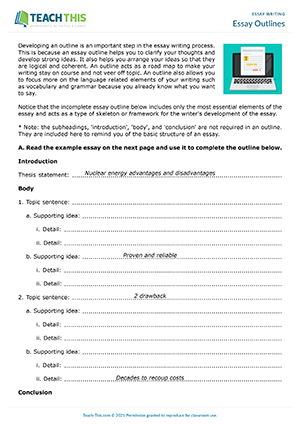
Essay Writing Review
Eap essay writing review worksheet - reading and writing exercises: writing paragraphs, identifying, error correction, matching, true or false questions - intermediate (b1) - 90 minutes.
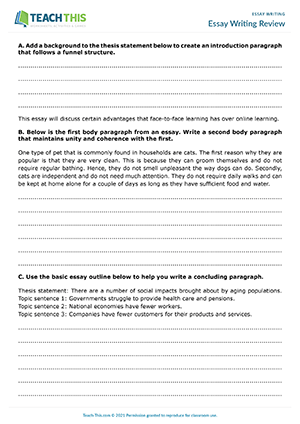
Fragments, Run-ons, and Comma Splices
Eap fragments, run-ons, and comma splices worksheet - reading and writing exercises: identifying, categorising, error correction - intermediate (b1-b2) - 30 minutes.
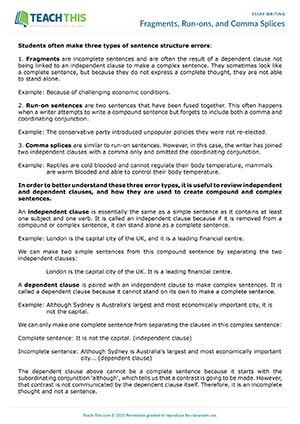
Introduction Paragraphs
Eap introduction paragraphs worksheet - reading and writing exercises: ordering, writing a thesis statement, paragraph completion, writing introduction paragraphs - intermediate (b1) - 75 minutes.
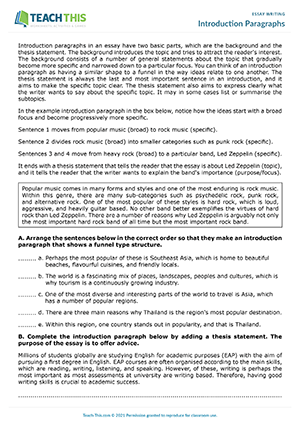
Paragraph and Essay Structure Comparison
Eap paragraph and essay structure worksheet - reading and writing exercises: table completion, short answer questions - intermediate (b1-b2) - 45 minutes.
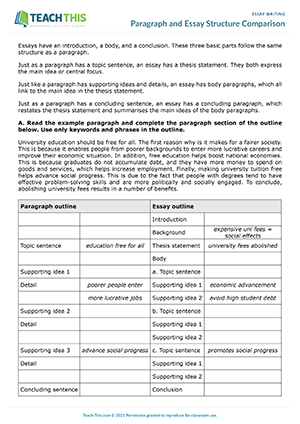
Parts of an Essay
Eap parts of an essay worksheet - reading and writing exercises: true or false, matching, labelling, brainstrorming, creating an essay outline, writing an essay - intermediate (b1-b2) - 90 minutes.
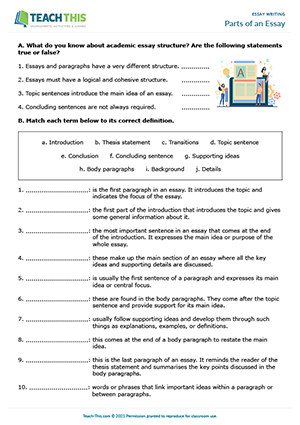
Hedging Language
Eap essay writing worksheet - reading and writing exercises: identifying, rewriting sentences, unscrambling, sentence combining, changing sentence structure - upper-intermediate (b2) - 25 minutes.
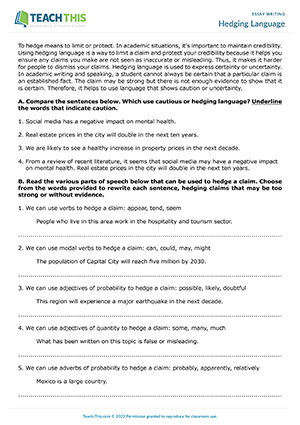
New Teaching Resources eBooks
Now Available!
Get Started Here
https://www.teach-this.com/esl-essentials
LATEST FREE RESOURCES
Elementary (A1-A2)
Upper-intermediate (B2)
Cities and Towns
Latest member resources.
Intermediate (B1)
Cities, Towns and Places
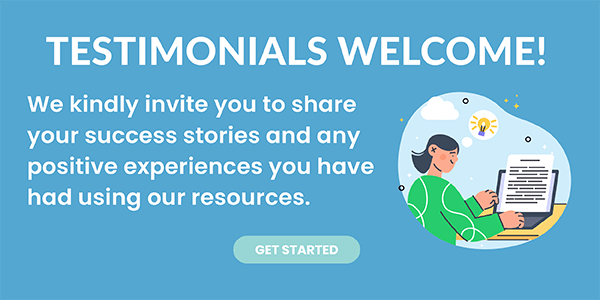
- Have got & Has got
- Adverbs of Affirmation and Negation
- Concrete nouns
- Sense Verbs & Adjectives
- Everyday Objects
- AWL Sublist 1 and 2
- Talking about Jobs
- TEFL Certification & Courses
- Privacy Policy
- Terms of Use
- Chess (Gr. 1-4)
- TV (Gr. 1-4)
- Metal Detectors (Gr. 2-6)
- Tetris (Gr. 2-6)
- Seat Belts (Gr. 2-6)
- The Coliseum (Gr. 2-6)
- The Pony Express (Gr. 2-6)
- Wintertime (Gr. 2-6)
- Reading (Gr. 3-7)
- Black Friday (Gr. 3-7)
- Hummingbirds (Gr. 3-7)
- Worst Game Ever? (Gr. 4-8)
- Carnivorous Plants (Gr. 4-8)
- Google (Gr. 4-8)
- Honey Badgers (Gr. 4-8)
- Hyperinflation (Gr. 4-8)
- Koko (Gr. 4-8)
- Mongooses (Gr. 5-9)
- Trampolines (Gr. 5-9)
- Garbage (Gr. 5-9)
- Maginot Line (Gr. 5-9)
- Asian Carp (Gr. 5-9)
- Tale of Two Countries (Gr. 6-10)
- Kevlar (Gr. 7-10)
- Tigers (Gr. 7-11)
- Statue of Liberty (Gr. 8-10)
- Submarines (Gr. 8-12)
- Castles (Gr. 9-13)
- Gutenberg (Gr. 9-13)
- Author's Purpose Practice 1
- Author's Purpose Practice 2
- Author's Purpose Practice 3
- Fact and Opinion Practice 1
- Fact and Opinion Practice 2
- Fact and Opinion Practice 3
- Idioms Practice Test 1
- Idioms Practice Test 2
- Figurative Language Practice 1
- Figurative Language Practice 2
- Figurative Language Practice 3
- Figurative Language Practice 4
- Figurative Language Practice 5
- Figurative Language Practice 6
- Figurative Language Practice 7
- Figurative Language Practice 8
- Figurative Language Practice 9
- Figurative Language of Edgar Allan Poe
- Figurative Language of O. Henry
- Figurative Language of Shakespeare
- Genre Practice 1
- Genre Practice 2
- Genre Practice 3
- Genre Practice 4
- Genre Practice 5
- Genre Practice 6
- Genre Practice 7
- Genre Practice 8
- Genre Practice 9
- Genre Practice 10
- Irony Practice 1
- Irony Practice 2
- Irony Practice 3
- Making Inferences Practice 1
- Making Inferences Practice 2
- Making Inferences Practice 3
- Making Inferences Practice 4
- Making Inferences Practice 5
- Main Idea Practice 1
- Main Idea Practice 2
- Point of View Practice 1
- Point of View Practice 2
- Text Structure Practice 1
- Text Structure Practice 2
- Text Structure Practice 3
- Text Structure Practice 4
- Text Structure Practice 5
- Story Structure Practice 1
- Story Structure Practice 2
- Story Structure Practice 3
- Author's Purpose
- Characterizations
- Context Clues
- Fact and Opinion
- Figurative Language
- Grammar and Language Arts
- Poetic Devices
- Point of View
- Predictions
- Reading Comprehension
- Story Structure
- Summarizing
- Text Structure
- Character Traits
- Common Core Aligned Unit Plans
- Teacher Point of View
- Teaching Theme
- Patterns of Organization
- Project Ideas
- Reading Activities
- How to Write Narrative Essays
- How to Write Persuasive Essays
- Narrative Essay Assignments
- Narrative Essay Topics
- Persuasive Essay Topics
- Research Paper Topics
- Rubrics for Writing Assignments
- Learn About Sentence Structure
- Grammar Worksheets
- Noun Worksheets
- Parts of Speech Worksheets
- Punctuation Worksheets
- Sentence Structure Worksheets
- Verbs and Gerunds
- Examples of Allitertion
- Examples of Hyperbole
- Examples of Onomatopoeia
- Examples of Metaphor
- Examples of Personification
- Examples of Simile
- Figurative Language Activities
- Figurative Language Examples
- Figurative Language Poems
- Figurative Language Worksheets
- Learn About Figurative Language
- Learn About Poetic Devices
- Idiom Worksheets
- Online Figurative Language Tests
- Onomatopoeia Worksheets
- Personification Worksheets
- Poetic Devices Activities
- Poetic Devices Worksheets
- About This Site
- Privacy Policy
- Terms of Use
- Understanding CCSS Standards
- What's New?
Ereading Worksheets
Free reading worksheets, activities, and lesson plans., site navigation.
- Learn About Author’s Purpose
- Author’s Purpose Quizzes
- Character Types Worksheets and Lessons
- List of Character Traits
- Differentiated Reading Instruction Worksheets and Activities
- Fact and Opinion Worksheets
- Irony Worksheets
- Animal Farm Worksheets
- Literary Conflicts Lesson and Review
- New Home Page Test
- Lord of the Flies Chapter 2 Worksheet
- Lord of the Flies Chapter 5 Worksheet
- Lord of the Flies Chapter 6 Worksheet
- Lord of the Flies Chapter 10 Worksheet
- Narrative of the Life of Frederick Douglass
- Sister Carrie
- The Count of Monte Cristo
- The Odyssey
- The War of the Worlds
- The Wizard of Oz
- Mood Worksheets
- Context Clues Worksheets
- Inferences Worksheets
- Main Idea Worksheets
- Making Predictions Worksheets
- Nonfiction Passages and Functional Texts
- Setting Worksheets
- Summarizing Worksheets and Activities
- Short Stories with Questions
- Story Structure Activities
- Story Structure Worksheets
- Tone Worksheets
- Types of Conflict Worksheets
- Reading Games
- Figurative Language Poems with Questions
- Hyperbole and Understatement Worksheets
- Simile and Metaphor Worksheets
- Simile Worksheets
- Hyperbole Examples
- Metaphor Examples
- Personification Examples
- Simile Examples
- Understatement Examples
- Idiom Worksheets and Tests
- Poetic Devices Worksheets & Activities
- Alliteration Examples
- Allusion Examples
- Onomatopoeia Examples
- Onomatopoeia Worksheets and Activities
- Genre Worksheets
- Genre Activities
- Capitalization Worksheets, Lessons, and Tests
- Contractions Worksheets and Activities
- Double Negative Worksheets
- Homophones & Word Choice Worksheets
- ‘Was’ or ‘Were’
- Simple Subjects & Predicates Worksheets
- Subjects, Predicates, and Objects
- Clauses and Phrases
- Type of Sentences Worksheets
- Sentence Structure Activities
- Comma Worksheets and Activities
- Semicolon Worksheets
- End Mark Worksheets
- Noun Worksheets, Lessons, and Tests
- Verb Worksheets and Activities
- Pronoun Worksheets, Lessons, and Tests
- Adverbs & Adjectives Worksheets, Lessons, & Tests
- Preposition Worksheets and Activities
- Conjunctions Worksheets and Activities
- Interjections Worksheets
- Parts of Speech Activities
- Verb Tense Activities
- Past Tense Worksheets
- Present Tense Worksheets
- Future Tense Worksheets
- Point of View Activities
- Point of View Worksheets
- Teaching Point of View
- Cause and Effect Example Paragraphs
- Chronological Order
- Compare and Contrast
- Order of Importance
- Problem and Solution
- Text Structure Worksheets
- Text Structure Activities
- Essay Writing Rubrics
- Narrative Essay Topics and Story Ideas
- Narrative Essay Worksheets & Writing Assignments
- Persuasive Essay and Speech Topics
Persuasive Essay Worksheets & Activities
- Writing Narrative Essays and Short Stories
- Writing Persuasive Essays
- All Reading Worksheets
- Understanding Common Core State Standards
- Remote Learning Resources for Covid-19 School Closures
- What’s New?
- Ereading Worksheets | Legacy Versions
- Online Figurative Language Practice
- Online Genre Practice Tests
- Online Point of View Practice Tests
- 62 School Project Ideas
- 2nd Grade Reading Worksheets
- 3rd Grade Reading Worksheets
- 4th Grade Reading Worksheets
- 5th Grade Reading Worksheets
- 6th Grade Reading Worksheets
- 7th Grade Reading Worksheets
- 8th Grade Reading Worksheets
- 9th Grade Reading Worksheets
- 10th Grade Reading Worksheets
- Membership Billing
- Membership Cancel
- Membership Checkout
- Membership Confirmation
- Membership Invoice
- Membership Levels
- Your Profile
Want Updates?
84 comments.
Thank you so much. This has truly helped me in my exams and throughout the beneficial journey of my school year.
Ellen Davis
How will I be able to check my work, when I print it out to work on them? Where are the answers?
I guess it depends on what you are working on. On what are you working?
Kareema Coles
Ummm the pdf version is not working…is the link still valid?
Which link?
This is an amazing website with fabulous ideas and printable ready to go lessons!!! Thank you so much! I wish I could meet you!!!
Thank you very much for this amazing resource and great ideas. They are extremely comprehensive and well designed. Thank you very much for your kind consideration and not adding a Price-tag to your valuable resources. Highly appreciated.
Sandra Conner
Thank you so much for sharing your knowledge and your work with us. As teachers, we are always in need of fresh material. I teach college level creative writing classes, and your worksheets help my students. Sometimes I change the essay topics to fit their particular age group or interest, but having these examples laid out for us and made available for use in our classrooms is wonderful.
Lifesaver! Thank you for the great ideas and guidance. I am a new teacher, and finding this site has made a true turn around in my instruction. Thank you, thank you, thank you!!!
Thank you for these great step by step resources
Macca Malbrán
Despite all the negative comments above, you should keep up for the ones (like me) who are absolutely grateful for these material.
Thanks for sharing! Best.
I give this website 3stares only for the info but in general 1star
I give your comment 0 stars because your position lacks support or evidence of any kind. Complete some of these worksheets and begin your argument again.
that’s stupid from where do u get the worksheets
I wrote them.
I did not see any activities that required the student to write an entire essay.
https://www.ereadingworksheets.com/writing/persuasive-essay-topics/
Lamar Mohamed
Thank you for this information! They helped me in my exam so much!
These are fantastic resources! Thank you so much for sharing them. I only wish I had found them earlier in the school year!
There’s always next year…
Thank you so much for all you do for teachers. I love an use practically everything on your Website!
That’s awesome. Thanks for visiting my website.
I really like this website
Shenard McDougal
How can a teacher get the answers to the worksheets?
Leave a Reply Cancel reply
Your email address will not be published. Required fields are marked *
Subscribe Now
Popular content.
- Author's Purpose Worksheets
- Characterization Worksheets
- Common Core Lesson and Unit Plans
- Online Reading Practice Tests
- Plot Worksheets
- Reading Comprehension Worksheets
- Summary Worksheets
- Theme Worksheets
New and Updated Pages
- Capitalization Worksheets
- Contractions Worksheets
- Double Negatives Worksheets
- Homophones & Word Choice Worksheets
BECOME A MEMBER!
Have a language expert improve your writing
Run a free plagiarism check in 10 minutes, generate accurate citations for free.
- Knowledge Base
- How to write an essay outline | Guidelines & examples
How to Write an Essay Outline | Guidelines & Examples
Published on August 14, 2020 by Jack Caulfield . Revised on July 23, 2023.
An essay outline is a way of planning the structure of your essay before you start writing. It involves writing quick summary sentences or phrases for every point you will cover in each paragraph , giving you a picture of how your argument will unfold.
Instantly correct all language mistakes in your text
Upload your document to correct all your mistakes in minutes

Table of contents
Organizing your material, presentation of the outline, examples of essay outlines, other interesting articles, frequently asked questions about essay outlines.
At the stage where you’re writing an essay outline, your ideas are probably still not fully formed. You should know your topic and have already done some preliminary research to find relevant sources , but now you need to shape your ideas into a structured argument.

Creating categories
Look over any information, quotes and ideas you’ve noted down from your research and consider the central point you want to make in the essay—this will be the basis of your thesis statement . Once you have an idea of your overall argument, you can begin to organize your material in a way that serves that argument.
Try to arrange your material into categories related to different aspects of your argument. If you’re writing about a literary text, you might group your ideas into themes; in a history essay, it might be several key trends or turning points from the period you’re discussing.
Three main themes or subjects is a common structure for essays. Depending on the length of the essay, you could split the themes into three body paragraphs, or three longer sections with several paragraphs covering each theme.
As you create the outline, look critically at your categories and points: Are any of them irrelevant or redundant? Make sure every topic you cover is clearly related to your thesis statement.
Order of information
When you have your material organized into several categories, consider what order they should appear in.
Your essay will always begin and end with an introduction and conclusion , but the organization of the body is up to you.
Consider these questions to order your material:
- Is there an obvious starting point for your argument?
- Is there one subject that provides an easy transition into another?
- Do some points need to be set up by discussing other points first?
Receive feedback on language, structure, and formatting
Professional editors proofread and edit your paper by focusing on:
- Academic style
- Vague sentences
- Style consistency
See an example

Within each paragraph, you’ll discuss a single idea related to your overall topic or argument, using several points of evidence or analysis to do so.
In your outline, you present these points as a few short numbered sentences or phrases.They can be split into sub-points when more detail is needed.
The template below shows how you might structure an outline for a five-paragraph essay.
- Thesis statement
- First piece of evidence
- Second piece of evidence
- Summary/synthesis
- Importance of topic
- Strong closing statement
You can choose whether to write your outline in full sentences or short phrases. Be consistent in your choice; don’t randomly write some points as full sentences and others as short phrases.
Examples of outlines for different types of essays are presented below: an argumentative, expository, and literary analysis essay.
Argumentative essay outline
This outline is for a short argumentative essay evaluating the internet’s impact on education. It uses short phrases to summarize each point.
Its body is split into three paragraphs, each presenting arguments about a different aspect of the internet’s effects on education.
- Importance of the internet
- Concerns about internet use
- Thesis statement: Internet use a net positive
- Data exploring this effect
- Analysis indicating it is overstated
- Students’ reading levels over time
- Why this data is questionable
- Video media
- Interactive media
- Speed and simplicity of online research
- Questions about reliability (transitioning into next topic)
- Evidence indicating its ubiquity
- Claims that it discourages engagement with academic writing
- Evidence that Wikipedia warns students not to cite it
- Argument that it introduces students to citation
- Summary of key points
- Value of digital education for students
- Need for optimism to embrace advantages of the internet
Expository essay outline
This is the outline for an expository essay describing how the invention of the printing press affected life and politics in Europe.
The paragraphs are still summarized in short phrases here, but individual points are described with full sentences.
- Claim that the printing press marks the end of the Middle Ages.
- Provide background on the low levels of literacy before the printing press.
- Present the thesis statement: The invention of the printing press increased circulation of information in Europe, paving the way for the Reformation.
- Discuss the very high levels of illiteracy in medieval Europe.
- Describe how literacy and thus knowledge and education were mainly the domain of religious and political elites.
- Indicate how this discouraged political and religious change.
- Describe the invention of the printing press in 1440 by Johannes Gutenberg.
- Show the implications of the new technology for book production.
- Describe the rapid spread of the technology and the printing of the Gutenberg Bible.
- Link to the Reformation.
- Discuss the trend for translating the Bible into vernacular languages during the years following the printing press’s invention.
- Describe Luther’s own translation of the Bible during the Reformation.
- Sketch out the large-scale effects the Reformation would have on religion and politics.
- Summarize the history described.
- Stress the significance of the printing press to the events of this period.
Literary analysis essay outline
The literary analysis essay outlined below discusses the role of theater in Jane Austen’s novel Mansfield Park .
The body of the essay is divided into three different themes, each of which is explored through examples from the book.
- Describe the theatricality of Austen’s works
- Outline the role theater plays in Mansfield Park
- Introduce the research question : How does Austen use theater to express the characters’ morality in Mansfield Park ?
- Discuss Austen’s depiction of the performance at the end of the first volume
- Discuss how Sir Bertram reacts to the acting scheme
- Introduce Austen’s use of stage direction–like details during dialogue
- Explore how these are deployed to show the characters’ self-absorption
- Discuss Austen’s description of Maria and Julia’s relationship as polite but affectionless
- Compare Mrs. Norris’s self-conceit as charitable despite her idleness
- Summarize the three themes: The acting scheme, stage directions, and the performance of morals
- Answer the research question
- Indicate areas for further study
If you want to know more about AI tools , college essays , or fallacies make sure to check out some of our other articles with explanations and examples or go directly to our tools!
- Ad hominem fallacy
- Post hoc fallacy
- Appeal to authority fallacy
- False cause fallacy
- Sunk cost fallacy
College essays
- Choosing Essay Topic
- Write a College Essay
- Write a Diversity Essay
- College Essay Format & Structure
- Comparing and Contrasting in an Essay
(AI) Tools
- Grammar Checker
- Paraphrasing Tool
- Text Summarizer
- AI Detector
- Plagiarism Checker
- Citation Generator
Prevent plagiarism. Run a free check.
You will sometimes be asked to hand in an essay outline before you start writing your essay . Your supervisor wants to see that you have a clear idea of your structure so that writing will go smoothly.
Even when you do not have to hand it in, writing an essay outline is an important part of the writing process . It’s a good idea to write one (as informally as you like) to clarify your structure for yourself whenever you are working on an essay.
If you have to hand in your essay outline , you may be given specific guidelines stating whether you have to use full sentences. If you’re not sure, ask your supervisor.
When writing an essay outline for yourself, the choice is yours. Some students find it helpful to write out their ideas in full sentences, while others prefer to summarize them in short phrases.
You should try to follow your outline as you write your essay . However, if your ideas change or it becomes clear that your structure could be better, it’s okay to depart from your essay outline . Just make sure you know why you’re doing so.
Cite this Scribbr article
If you want to cite this source, you can copy and paste the citation or click the “Cite this Scribbr article” button to automatically add the citation to our free Citation Generator.
Caulfield, J. (2023, July 23). How to Write an Essay Outline | Guidelines & Examples. Scribbr. Retrieved June 19, 2024, from https://www.scribbr.com/academic-essay/essay-outline/
Is this article helpful?

Jack Caulfield
Other students also liked, how to create a structured research paper outline | example, a step-by-step guide to the writing process, how to write an argumentative essay | examples & tips, "i thought ai proofreading was useless but..".
I've been using Scribbr for years now and I know it's a service that won't disappoint. It does a good job spotting mistakes”
- Skip to main content
- Skip to ChatBot Assistant
- Student Degree Planning Guide
- Prior Learning Assessment
- PLA Evaluator Resources
- Alternative Credit Project
Rationale Worksheet
Ra-tion-ale (noun) 1. Fundamental reasons; the basis 2. An exposition of principles or reasons
The American Heritage® Dictionary of the English Language, 4th ed. 2003.
- Background Information about You and Your Goals
- Overall Degree Program Design
- Concentration
- General Learning
- Breadth, Progression and Integration
- SUNY and Empire State College Degree Requirements
- Advanced Standing Studies
- Empire State College Studies
- Special Considerations
Using the Worksheet
The following worksheet can help you to understand better what is expected in a rationale essay. It will also help you to incorporate your personal and professional information in a meaningful way. When completed, the worksheet can serve as an outline for your rationale.
However, please be aware that this is a worksheet only; it cannot serve as a substitute for your rationale.
There are a couple of different ways you can use this worksheet:
- Write brief answers and then expand on these when you actually write your rationale.
- Use the worksheet as an outline and develop more extensive answers directly in a word processing program. These entries can then serve as a first draft of your rationale.
Do your best to carefully reflect on the questions posed in the worksheet and answer them as best as you can. If you do, you should have the foundation for a very good rationale.
I. Background Information about You and Your Goals
The essay discussion of goals is usually the first portion of the essay, so readers can get a sense of the context in which you're pursuing your degree. Use these questions to help you think and write about goals:
- What are your personal, professional, and educational goals?
- Why do you want to pursue your degree? Provide enough background so that readers can understand the reasons that led you to pursue a degree and the results you expect to achieve by pursuing your degree. How do you intend to use your degree?
- What knowledge, qualities, or characteristics do you hope to develop through your studies?
- What do you want to learn through this degree? How will you combine your previous learning with new learning to develop your academic area and become a more fully-educated person? Based on any self-assessments you have done, and any previous college coursework (at SUNY Empire or other colleges), do you need to strengthen certain academic skill areas or develop certain perspectives?
- What degree(s) are you seeking at Empire State College?
- Where would you like to be professionally in five or ten years?
- How will your degree help you to reach your professional goals?
II. Research
- Which Empire State College area of study guidelines are relevant to your concentration? Explain what you learned from reviewing them.
- Did you review catalogs or online degree program and/or course descriptions from other colleges and universities? Be specific. Name the institutions and the programs you consulted. What did you learn from these catalogs? What courses are common to each program you reviewed?
- Did you consult professionals or academics who are experienced in the area of your degree program concentration? Who were they? What did you learn? Did you incorporate their advice into your degree program by adding specific studies?
- Did you consult a graduate program advisor or a graduate catalog if you plan to continue your studies beyond the bachelor’s level? What institution? What did you learn? How did this knowledge affect your choice of studies?
- Did you review journal articles, books, or chapters of books? What did you read? What did you learn? How did this knowledge affect your choice of studies?
- Did you investigate employment or career opportunities? How? What did you learn? How did this knowledge affect your choice of studies?
III. Overall Degree Program Design
- What is the framework or organization of your degree?
- Why did you choose this framework or organization? How does it best meet your goals?
- What is your area of study? Why did you chose that area? How does it best meet your goals?
IV. Concentration
- What is your concentration? Are you using an established concentration with guidelines or have your developed your own? If you have developed your own concentration, how have you organized it?
- How does your concentration best meet your goals? How does it represent the learning that you have acquired?
- How does your concentration meet the area of study guidelines? If you have developed your own concentration, how have you designed it to meet the area of study guidelines?
- Are all the studies listed in the concentration column consistent with the concentration’s title? If so, can you explain why?
- How do your concentration studies work together to form a coherent degree program?
- How do they provide a foundation for advanced studies?
- How do they support a progression of your learning?
- How do they support an integration of your learning?
- How do they provide breadth so that your concentration isn’t too narrowly focused on one subject?
- How do they fulfill academic expectations uncovered during your research?
- How do they help your degree program meet expectations for advanced-level credits (bachelor’s only)?
V. General Learning
- How do they provide overall breadth to your degree program?
- Do any of them fulfill a SUNY General Education requirement? How?
- How do any of your general learning studies complement your concentration? How?
VI. Breadth, Progression and Integration
Note: You may have already explained breadth, progression and integration of your studies in earlier sections, especially in the sections on your concentration and general learning. If you want to make some additional points on how some of your learning especially provides your degree with breadth, progression and integration, you can elaborate more.
- How do your advanced standing and Empire State College studies provide breadth, progression and integration in your degree?
VII. SUNY and Empire State College Degree Requirements
Note: You may have already explained how your studies have met the SUNY and Empire State College requirements in earlier sections. You may, however, want to elaborate more if you have only mentioned the requirements and not explained how you have met them.
- How have you met the SUNY general education requirements? In what ways are they meeting these requirements? How have you infused the critical thinking and information management competencies into your degree?
- How does your degree program meet the requirements for liberal arts and science credits? How do you define “liberal arts and science” studies? How do your designated studies fit your definition?
- Does your bachelor’s degree program include sufficient advanced-level credits overall (45 are required)? Within your concentration (24 are required)? Advanced-level credits can be included in an associate degree, but they aren’t required. How do these studies support the progression of your degree?
VIII. Advanced Standing Studies
Note: You may have already explained why you are using some of your advanced standing studies in earlier sections. You may, however, want to elaborate more if you have only mentioned them and not explained why you have decided to use them in your degree.
Don’t list individual courses, but describe them in general or group them together in ways that you see that they are related and were of greatest interest or importance to you. Give the readers some sense of the learning the you bring to your degree.
- Why have you chosen to use the advanced standing studies that you have in your degree?
- How have the transcript or prior learning studies augmented your knowledge in your degree?
- How have they helped you meet your goals?
- How have they shaped what studies you decided to take at Empire State College?
IX. Empire State College Studies
Note: You may have already explained why you have chosen certain Empire State College studies in earlier sections. You may, however, want to elaborate more if you have only mentioned them and not explained why you have decided to use them in your degree.
- Why have you chosen the Empire State College studies that you have in your degree?
- How do your Empire State College studies build on your prior learning?
- How have the Empire State College studies helped you meet your goals?
- How have you shaped these studies to complete your knowledge for your degree?
X. Special Considerations
Note: You may have already explained any special considerations in earlier sections, but you may want to elaborate on some to make sure that the readers understand why you have made the decisions that you have.
- If there are any important points you want to make about your choices in your degree, you should take the time to explain them. Make sure that you have explained why you have made the choices that you have in the design of your degree.
- Explain why if you have deviated from any of the academic or professional expectations. If expected learning is missing or not readily apparent on the degree program itself, your rationale should explain its absence.
- If your concentration is unique or fairly nontraditional, explain why you chose the studies that make up your concentration and how they work together to form a sound college degree.
- If some of your learning may appear to have potential redundancy by their titles, explain the differences in your learning.
- If you plan to pursue a career in education or in accounting, you need to address that you recognize that your degree will not meet all of the state licensing requirements and sign a Teacher Certification Disclaimer or Accounting Certification Disclaimer.
Smart Cookies
They're not just in our classes – they help power our website. Cookies and similar tools allow us to better understand the experience of our visitors. By continuing to use this website, you consent to SUNY Empire State University's usage of cookies and similar technologies in accordance with the university's Privacy Notice and Cookies Policy .

How to plan an essay: Essay Planning
- What's in this guide
- Essay Planning
- Additional resources
How to plan an essay
Essay planning is an important step in academic essay writing.
Proper planning helps you write your essay faster, and focus more on the exact question. As you draft and write your essay, record any changes on the plan as well as in the essay itself, so they develop side by side.
One way to start planning an essay is with a ‘box plan’.
First, decide how many stages you want in your argument – how many important points do you want to make? Then, divide a box into an introduction + one paragraph for each stage + a conclusion.
Next, figure out how many words per paragraph you'll need.
Usually, the introduction and conclusion are each about 10% of the word count. This leaves about 80% of the word count for the body - for your real argument. Find how many words that is, and divide it by the number of body paragraphs you want. That tells you about how many words each paragraph can have.
Remember, each body paragraph discusses one main point, so make sure each paragraph's long enough to discuss the point properly (flexible, but usually at least 150 words).
For example, say the assignment is
Fill in the table as follows:
| Discuss how media can influence children. Use specific examples to support your views. | |
|---|---|
| 120 words | |
| 240 words | |
| 240 words | |
| 240 words | |
| 240 words | |
| 120 words |
Next, record each paragraph's main argument, as either a heading or topic sentence (a sentence to start that paragraph, to immediately make its point clear).
| Discuss how media can influence children. Use specific examples to support your views. | ||
|---|---|---|
|
| 120 words | |
|
Not all media can be treated as the same. | 240 words | |
|
Media can have beneficial outcomes. | 240 words | |
|
Media can also have harmful effects. | 240 words | |
|
Amount, type, variety and quality of content are all-important. | 240 words | |
|
| 120 words | |
Finally, use dot points to list useful information or ideas from your research notes for each paragraph. Remember to include references so you can connect each point to your reading.
| Discuss how media can influence children. Use specific examples to support your views. | ||
|---|---|---|
| 1. General introduction statement 2. Thesis statement 3. Order of arguments | 120 words | |
|
Not all media can be treated as the same.
- There are many types of media/programs. - People use media in many different ways. - We can't assume it always has the same effects. - Media such as tablets give children active control over their consumption ( ). | 240 words | |
|
Media can have beneficial outcomes.
- A wide range of programs are tailored for children ( ). - A lot of media builds social skills or is educational ( ). - Media is a major way of introducing new themes and topics to a child's awareness. | 240 words | |
|
Media can also have harmful effects.
- Parents can't always monitor the child's consumption (amount or type). - Media can create peer pressure and/or feelings of entitlement ( ). - Overconsuming media reduces contact with real people ( ). | 240 words | |
|
Amount, type, variety and quality of content are all-important.
- Studies find no harmful effects from average consumption ( ). - Studies find various harms from overconsumption/meaningless consumption ( ). | 240 words | |
| 1. Restate thesis 2. General conclusions 3. Final concluding statement | 120 words | |
The other useful document for essay planning is the marking rubric .
This indicates what the lecturer is looking for, and helps you make sure all the necessary elements are there.
Pathways and Academic Learning Support

- << Previous: What's in this guide
- Next: Additional resources >>
- Last Updated: Feb 15, 2024 1:23 PM
- URL: https://libguides.newcastle.edu.au/essay_planning
| > > |
| |
|---|
| to print. Line-by-line color-coded organizer to familiarize students with the nuts and bolts of basic essay-writing and organization. This chart shows students line-by-line how to write an essay. Teachers give students this sheet, and students proceed to fill it in. Once this sheet of essay notes has been completed, students use it to create a five-paragraph essay. This sheet is especially useful with students who have little or no experience with formal writing. Check out more of our free . |
| All materials on this website are © www.studenthandouts.com unless otherwise noted. Please contact us via Facebook or Twitter with any questions. - - - |
| Note: Product links are paid affiliate links. All links are deemed relevant and are not placed merely for profit. Purchase through these links helps to keep this educational website online and free. |
Filter Results
- clear all filters
Resource Type
- Worksheets
- Guided Lessons
- Lesson Plans
- Hands-on Activities
- Interactive Stories
- Online Exercises
- Printable Workbooks
- Science Projects
- Song Videos
middle-school
- Fine arts
- Foreign language
- Math
- Reading
- Writing Process
- Writing Organization and Structure
- Genre Writing
- Fiction Writing
- Reflective Writing
- Research Writing
- Informational Writing
- Opinion Writing
- Persuasive Writing
- Argument Writing
- Narrative Writing
- Essay Writing
- Response to Literature
- Grammar
- Science
- Social emotional
- Social studies
- Typing
- Holidays
- Seasonal
- Teacher Resources
- Common Core
Fifth Grade Essay Writing Worksheets and Printables

Resources you can trust
Essay planning
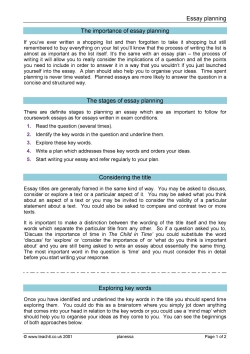
An excellent, student-friendly guide for A-level students about the benefits of essay planning, and covering all the stages of planning. Includes detailed guidance on how to approach a KS5 essay question or title and how to identify the key or command words of the question.
An extract from the lesson worksheet:
The stages of essay planning
There are definite stages to planning an essay which are as important to follow for coursework essays as for essays written in exam conditions.
- Read the question (several times).
- Identify the key words in the question and underline them.
- Explore these key words.
- Write a plan which addresses these key words and orders your ideas.
- Start writing your essay and refer regularly to your plan.
Considering the title
Essay titles are generally framed in the same kind of way. You may be asked to discuss, consider or explore a text or a particular aspect of it. You may be asked what you think about an aspect of a text or you may be invited to consider the validity of a particular statement about a text. You could also be asked to compare and contrast two or more texts.
All reviews
Have you used this resource?
Resources you might like
- International
- Education Jobs
- Schools directory
- Resources Education Jobs Schools directory News Search
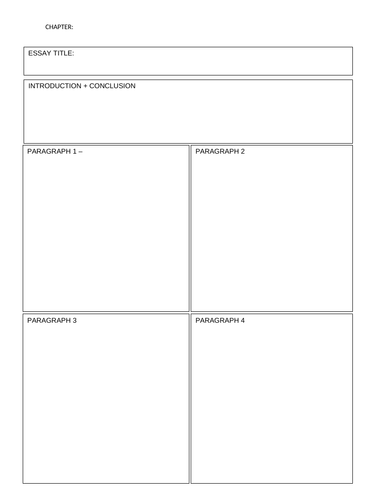
Free Essay Plan Template for A-levels
Subject: History
Age range: 14-16
Resource type: Worksheet/Activity
Last updated
21 December 2023
- Share through email
- Share through twitter
- Share through linkedin
- Share through facebook
- Share through pinterest

Free Essay Plan Template suitable for A-level essay subjects.
- A-level History, Psychology, English, Politics and others.
- Use the introduction/conclusion box to list/bullet point key ideas; i.e. 4 key points.
- The other 4 boxes dedicated to paragraphs should include more detail in bullet points about each of the 4 key points.
- This template has been successfully used by high achieving A-level History students previously.
- can also be tailored to teach essay structure to lower secondary school - Year 7s and 11s.
Creative Commons "NoDerivatives"
Your rating is required to reflect your happiness.
It's good to leave some feedback.
Something went wrong, please try again later.
This resource hasn't been reviewed yet
To ensure quality for our reviews, only customers who have downloaded this resource can review it
Report this resource to let us know if it violates our terms and conditions. Our customer service team will review your report and will be in touch.
Not quite what you were looking for? Search by keyword to find the right resource:

COMMENTS
Essay writing is a crucial skill as students traverse the path from elementary school to college and eventually the professional world. Our essay writing worksheets will equip them with everything they need for the journey. Informational, opinion, persuasive, and narrative text types are presented in innovative ways.
EAP Parts of an Essay Worksheet - Reading and Writing Exercises: True or False, Matching, Labelling, Brainstrorming, Creating an Essay Outline, Writing an Essay - Intermediate (B1-B2) - 90 minutes. In this free parts of an essay worksheet, students learn about the various parts that make up an academic essay and practice writing a structured ...
Beyond that, there are a few more tricks that one can use to enhance one's skills quickly. These persuasive essay worksheets and activities will help students master these tricks. Creating Persuasive Attention Catchers Activity - Students practice creating persuasive leads that immediately push the reader toward their side of the argument.
Harvard College Writing Center 2 Tips for Reading an Assignment Prompt When you receive a paper assignment, your first step should be to read the assignment
There is an Outline worksheet on the back of this page to help you start planning the content, order and organization of your essay. Paragraph 1: Introduction -- If possible, open with an attention-getting device to interest the reader (perhaps a quote or question). Introduce the topic of your essay in general, and present some context for this ...
An essay outline is a way of planning the structure of your essay before you start writing. It involves writing quick summary sentences or phrases for every point you will cover in each paragraph, giving you a picture of how your argument will unfold. You'll sometimes be asked to submit an essay outline as a separate assignment before you ...
Outlining is a vital part of the essay planning process. It allows the writer to understand how he or she will connect all the information to support the thesis statement and the claims of the paper. It also provides the writer with a space to manipulate ideas easily without needing to write complete paragraphs.
Brainstorming will help you get started with your argumentative essay. In this section, you will choose a topic for your essay, write your thesis statement, think about several supporting ideas for your opinion, and think about the counterargument. Planning your Essay Follow the steps below to develop ideas for an argument essay. 1.
Offer some more specific background information (as needed). 3. Provide the title of the piece and the author's name if the essay is about a specific book/poem/article/passage. C. Thesis Statement 1. State your topic and position. Remember that a thesis = claim + reasons. 2. Outline your main points and ideas.
The following worksheet can help you to understand better what is expected in a rationale essay. It will also help you to incorporate your personal and professional information in a meaningful way. When completed, the worksheet can serve as an outline for your rationale. However, please be aware that this is a worksheet only; it cannot serve as ...
GCSE English Essay Planning Template. Subject: English. Age range: 14-16. Resource type: Worksheet/Activity. File previews. docx, 14.56 KB. This is a step-by-step template for essay planning. It is 2 pages. My GCSE set has improved massively just using this template to help organise their ideas.
An essay planning framework in the shape of a house to illustrate an example essay structure for visual learners. Students respond to an essay question on the presentation of the Lyons family in Blood Brothers. A handy template which provides a visual framework for KS4 students to help them to answer an essay question on 'Blood Brothers'.
The Persuasion Map is an interactive graphic organizer that enables students to map out their arguments for a persuasive essay or debate. Students begin by determining their goal or thesis. They then identify three reasons to support their argument, and three facts or examples to validate each reason. The map graphic in the upper right-hand ...
Essay planning is an important step in academic essay writing. Proper planning helps you write your essay faster, and focus more on the exact question. As you draft and write your essay, record any changes on the plan as well as in the essay itself, so they develop side by side. One way to start planning an essay is with a 'box plan'.
Argumentative Essay Planning Sheet My Topic and my side Reason 1 and three facts and/or stats that support that reason Reason: 1. 2. 3. Sources: Reason 2 and three facts and/or stats that support that reason Reason: 1. 2. 3. Sources: Reason 3 and three facts and/or stats that support that reason Reason: 1. 2. 3. Sources: Counterclaim 1 and
Line-by-line color-coded organizer to familiarize students with the nuts and bolts of basic essay-writing and organization. This chart shows students line-by-line how to write an essay. Teachers give students this sheet, and students proceed to fill it in. Once this sheet of essay notes has been completed, students use it to create a five-paragraph essay.
Browse Printable Informative Essay Structure Worksheets. Award winning educational materials designed to help kids succeed. Start for free now! ... an informational essay about a summer topic like vacations, swimming pools, or outside games. Inspire your students to plan their essay with this summer-themed graphic organizer. 2nd grade. Reading ...
PHI105 T4 Outline Worksheet Persuasive Essay Planning. worksheet. Course. 21st Century Skills: Critical Thinking and Problem Solving (PHI-105) 999+ Documents. Students shared 1734 documents in this course. University Grand Canyon University. Academic year: 2023/2024. Uploaded by: Amelia Mccradic. Grand Canyon University. 0 followers.
Respond to Art: Opinion & Evidence #2. Worksheet. Make an Argument! Worksheet. Hyperboles in History. Worksheet. 1 2. Fifth grade students are expected to master and utilize many skills when developing and writing essays. Our fifth grade essay writing worksheets will give them the encouragement they need to remain composed while composing.
T1 Topicand Audience Worksheet PHI105 Persuasive Essay Planning 9 5 22; Topic 1 UNV-105 Critical Reflection; Critical thinking essay; CWV 101 301 RS T4Who Do You Say Jesus Is Online; Related documents. Phi105Outline - PHI-105; School - hiiiiiiiiiiiiiiii; PHI105 T2 Brainstorming Worksheet 4 13 2023;
An extract from the lesson worksheet: The stages of essay planning. There are definite stages to planning an essay which are as important to follow for coursework essays as for essays written in exam conditions. Read the question (several times). Identify the key words in the question and underline them. Explore these key words.
Resource type: Worksheet/Activity. Affaf's Shop. 3.00 1 reviews. Last updated. 21 December 2023. Share this. Share through email; Share through twitter; Share through linkedin; Share through facebook; Share through pinterest; File previews. docx, 23.81 KB. Free Essay Plan Template suitable for A-level essay subjects. A-level History ...